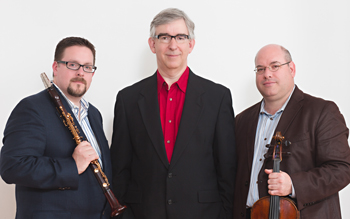by Daniel Hathaway

Three fine chamber musicians who play viola, clarinet and piano and want to concertize together need to do some research. That’s not a standard configuration of instruments. What repertory exists — like Mozart’s Kegelstatt Trio (not included on Wednesday’s program) — was usually written for domestic use by friends and family.
Case in point: Max Bruch’s Eight Pieces, op. 83, were composed for Bruch’s clarinetist son, Max. The Hawkeye elected to play two sets of four pieces each at the beginning and end of their program, leading off with Nos. 8, 6, 5 and 7 and finishing with the first four, in order.
The only works on the program to involve all three players, the “Eight” are essentially salon pieces of quasi-Brahmsian character and considerable charm. Bruch never intended them to be played as a suite, but when divided and separated by modern works as Hawkeye did, the stylistically similar pieces gain in impact and variety.
Bruch takes several approaches to combining the melodic instruments. They alternate motives, they echo each other polyphonically, they often play in unison. In all of those circumstances, Strauss and Hawkins beautifully matched their individual tones, dark and rich, and their unisons were splendidly blended and perfectly in tune. Howsmon, Strauss and Hawkins were of one mind about rubatos and musical nuances. The lyrical movements were lovely, the stormier and more energetic movements thrilling.
Between the two sets of Bruch pieces came introspective works by British composers Benjamin Britten and Rebecca Clarke. Britten’s Lachrymae, subtitled “Reflections on a Song of John Dowland,” was written for the American violist William Primrose and premiered at the composer’s Aldeburgh Festival in 1950 with the composer at the piano. Its moody deconstruction of Dowland’s lute song, If my complaints could passion move, takes the form of a set of variations which begin abstractly and grow more lyrical until the tune is finally given out whole at the end. Strauss and Howsmon put Britten’s well-constructed, often astringent music across with dedication and conviction.
Clarke, a violist herself, was visiting New York when the second world war broke out and remained there until her death in 1979 at the age of 93. She wrote the bucolic Prelude, Allegro and Pastorale for viola and clarinet for her clarinetist brother and his wife. No piano here, so the viola fills out textures with double stops and open fifths. Once again, Strauss and Hawkins matched each other brilliantly, taking primary and secondary roles as the mildly modern music demanded. Strauss’s longish solo at the beginning of the doleful Pastorale was eloquent.
Part of the attractiveness of the 90-minute program was its easy mix of the formal and the casual. Strauss, the group’s amiable spokesperson, began by not quite resolving the question of how the trio arrived at its name. Plausible answers: the players were all Mash fans; the University of Iowa in Strauss’s home state has Herky the Hawk for a mascot; it sounds like Richard Hawkins’s surname. Or all of the above. More important than its name is the strength and cohesiveness of the new trio’s playing. Let’s hope that they continue to find interesting music to play together. One wind instrument, one string instrument and piano make a rich and refreshing chamber music ensemble and allows for interesting duet combinations, as Hawkeye proved on Wednesday evening.
Published on ClevelandClassical.com October 1, 2013
Click here for a printable version of this article.



